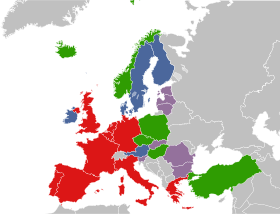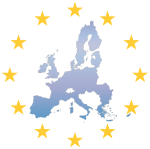Western European Union
|
Union de l'Europe occidentaleWestern European Union
|
||||
|---|---|---|---|---|
|
||||
 Members • Associate members • Observers • Associate partners
|
||||
| Membership | 10 member states 6 associate member states 5 observer countries 7 associate partner countries |
|||
| Establishment | Treaty of Brussels | |||
| - | Signed | 17 March 1948 | ||
The Western European Union (WEU) is a partially dormant European defence and security organization, established on the basis of the Treaty of Brussels of 1948 with the accession of West Germany and Italy in 1954. It should not be confused with the European Union (EU). The WEU headquarters are in Brussels.
Contents |
Treaty of Brussels
- Main article: Treaty of Brussels 1948.
The Treaty of Brussels was signed by the United Kingdom, France, Belgium, Luxembourg, and the Netherlands on 17 March 1948. It was a mutual intergovernmental self defence treaty which also promoted economic, cultural and social collaboration. As a result of the failure of the European Defence Community on 23 October 1954 the WEU was established by the Paris Agreements with the incorporation of the then West Germany and Italy. The signatories of the Paris Agreements clearly stated their three main objectives in the preamble to the modified Brussels Treaty:
- To create in Western Europe a firm basis for European economic recovery;
- To afford assistance to each other in resisting any policy of aggression;
- To promote the unity and encourage the progressive integration of Europe.
The defence efforts resulting from the Brussels Treaty took form as the Western Union Defence Organisation.
The Brussels Pact had cultural and social clauses, concepts for the setting up of a 'Consultative Council'. The basis for this was that a cooperation between Western nations would help stop the spread of Communism. The Treaty of Brussels was amended by the Protocol signed in Paris at the conclusion of the London and Paris Conferences on 23 October 1954, which added West Germany and Italy to the Western Union. On this occasion it was renamed the Western European Union.
Organization
The WEU is composed with the Council of the WEU (the Council) and the Assembly of the WEU (the Assembly).
Council
The WEU is led by a Council of Ministers, assisted by a Permanent Representatives Council on ambassadorial level. Social and cultural aspects of the Brussels Treaty were handed to the Council of Europe to avoid duplication of responsibilities within Europe.[1]
Assembly
A Parliamentary Assembly (composed of the delegations of the member states to the Parliamentary Assembly of the Council of Europe) supervise the work of the Council, but it does not have any obligations on the Council. The Assembly of WEU is a consultative institution.
Current status and future
| European Union | ||
 This article is part of the series: |
||
| Leaders | ||
|---|---|---|
|
European Council |
||
| Sub-policies | ||
|
Security and Defence Policy |
||
| Bodies | ||
|
Political and Security Committee |
||
| Military forces | ||
|
||
Originally, under the Amsterdam Treaty, the WEU was given an integral role in giving the EU an independent defence capability, playing a major role in the Petersberg tasks; however that situation is changing. On 13 November 2000, WEU Ministers met in Marseille and agreed to begin transferring the organisation's capabilities and functions to the European Union, under its developing Common Foreign and Security Policy (CFSP) and European Security and Defence Policy (ESDP)[2].
For example, on 1 January 2002, the WEU's Security Studies Institute and the Satellite Centre were transferred to the EU and became the European Union Institute for Security Studies and the European Union Satellite Centre. Notably, the role given to the WEU in the Amsterdam Treaty, was removed by the Nice Treaty and the European Constitution gives the role of collective defence to NATO[3]. However the defence commitment, of Article 4 of the Brussels Treaty, has not been subsumed[4]. Article 42(7) of the Treaty of the European Union, once amended by the Treaty of Lisbon, could be viewed as incorporating that defence commitment into the EU framework.[5]
A summary of some of the moves towards a merger of the WEU into the EU;
- On 20 November 1999, Javier Solana, who is the High Representative for the Common Foreign and Security Policy (CFSP) of the EU, was also appointed Secretary-General of the WEU. His being head of both organisations permits him to oversee the ongoing transfer of functions from the WEU to the EU.
- The Petersberg tasks, declared by the WEU in 1992, were incorporated in 1997 into the treaty of Amsterdam of the EU, forming the basis of the European Security and Defence Policy which frames a common policy to deal with humanitarian and rescue, peacekeeping and tasks of combat forces in crisis management, including peacemaking.
- The European Union Institute for Security Studies (EUISS) and European Union Satellite Centre (EUSC), both established to function under the EU's CFSP pillar, are replacements to the Western European Union Institute for Security Studies and the Western Union Satellite Centre which had been established to function in connection to the WEU.
With the transfer of responsibilities, the WEU's Parliamentary assembly was urged to dissolve itself, as it had a mandate to supervise WEU politics, not the EU's ESDP politics. But the Assembly saw itself as playing an important role, particularly with greater right of scrutiny, membership, experience and expertise in defence policy. Therefore, it renamed itself the "Interim European Security and Defence Assembly" and urged the European Convention to include it as a second chamber within the EU's institutional framework. Hence it argued it could effectively scrutinise the ESDP, help improve EU-NATO relations and be more suited, being composed of national parliamentarians, to the intergovernmental style of the ESDP.
However with the European Constitution aiming to streamline and simplify the EU's foreign policy, for example combining the two main foreign policy posts, it was not seen as wise to then create a separate double legislature for the CFSP, instead, the European Parliament was granted greater scrutiny over foreign policy.[6]
The full merger of WEU into the EU is not yet achieved, or even certain. Even though functions such as crisis-management now fall under the EU, wider membership could mean it continues to exist in some form for a while.[7]. Jolyon Howorth's book, Defending Europe, paints the situation as a "revival of the WEU" rather than a shutting down of it.
Participating states
The Western European Union has 10 member countries, 6 associate member countries, 5 observer countries and 7 associate partner countries. On 14 June 2001, Solana stated that there was no foreseeable reason to change the status of the non member countries in the organisation.
| Member countries: (modified Brussels Treaty - 1954)
All of them being members of both NATO and the European Union (though France is currently not integrated in the military command of NATO). These are the only nations that have full voting rights.
Observer countries: (Rome - 1992) Observer countries are members of the European Union, but not of NATO. 1 1 Denmark is an exception, being member of both. It has an opt-out from the Treaty of Maastricht (1992), so that it does not participate in the ESDP of the European Union. Thus in respect to the WEU it would have been more appropriate for it to be regarded as non-EU NATO member state (WEU associate status). |
Associate member countries: (Rome - 1992)
Associate membership was created to include the European countries that were members of NATO but not of the European Union. Since then, Poland, the Czech Republic and Hungary have also joined the EU. Associate partner countries: (Kirchberg - 1994) Countries that at the time were part of neither NATO nor of the EU. All of the following nations have since joined both NATO and the EU. |
Eurofor
On 15 May 1995, the Council of Ministers of the WEU met in Lisbon. Declaration of Eurofor's (European Operational Rapid Force) creation was made by France, Italy, Spain and Portugal. Eurofor became operational in June 1998 as a task force of the Western European Union.[8]
Subsidiary bodies
Western European Armaments Group (WEAG) was established as a forum for armaments cooperation in 1976 with the aim of creating a European Armaments Agency. Its membership reached 19 in 2000: Austria, Belgium, Czech Republic, Denmark, Finland, France, Germany, Greece, Hungary, Italy, Luxembourg, Netherlands, Norway, Poland, Portugal, Spain, Sweden, Turkey and the United Kingdom. The body closed on 23 May 2005. WEAG website
Western European Armaments Organisation (WEAO) was intended as an Armaments Agency but operations were limited to a research cell. It provided support services in defence research and technology. It was created in 1996, and closed in August 2006. WEAO Website
A large part of the work of these two agencies has now been taken over by the European Defence Agency.
See also
- List of Military alliances
- Collective defense
- Collective security
- Flag of the Western European Union
- European Defence Agency
- Western Europe
References
- ↑ the Western European Union ena.lu
- ↑ Marseille Declaration 2000 weu.int
- ↑ Western European Union (WEU) europa.eu
- ↑ EU Security Policy & the Role of the European Commission ec.europa.eu
- ↑ House of Lords - European Union - Tenth Report
- ↑ Occasional Paper n.57: The democratic legitimacy of the European Security and Defence Policy European Union Institute for Security Studies, April 2005
- ↑ WRITTEN QUESTION E-3750/00 by Ioannis Marínos (PPE-DE) to the Council. Incorporation of the WEU within the EU. eur-lex.europa.eu
- ↑ Eurofor eurofor.it
External links
- WEU official web site
- Assembly of the Western European Union; Assembly of the Western European Union
- History of NATO – the Atlantic Alliance - UK Government site
- the Western European Union European NAvigator
- WEU evolution: The presentation of the Eurocorps-Foreign Legion concept at the European Parliament in June 2003
|
||||||||||||||||
